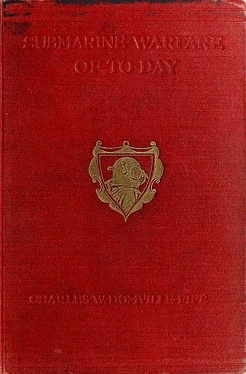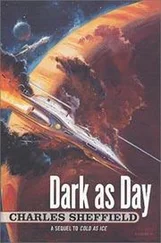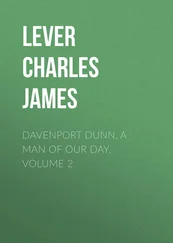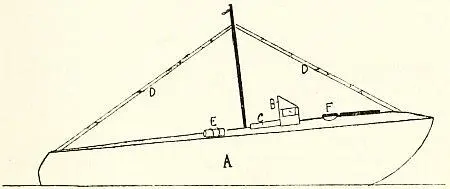
Fig. 3.—Diagram showing principal characteristics of a coastal motor boat (C.M.B.). Speed 50 miles per hour. A. Hydroplane hull, so constructed as to rise on to surface when travelling at full speed. B. Covered wheel-house. C. Navigating well. D. Wireless aerials. E. Depth charges (2 small size). F. Manhole to engine-room.
There were three types of C.M.B.’s. One had a length of only 44 feet, and was intended for carriage on the decks of light cruisers or other moderate-sized surface ships. The armament was a Lewis machine gun and two depth charges for anti-submarine warfare. The next class were 55 feet in length and operated from coast bases. These were fitted with one or more Whitehead torpedoes, launched by an ingenious contrivance from the stern. Class III. were 70 feet in length, and were commissioned just before the signing of the Armistice. They were fitted for mine-laying close up to enemy harbours.

Fig. 4.—Plan of coastal motor boat, showing torpedo in cleft stern. A. Whale-back or arched deck. B. Wheel-house. C. Navigating well. D. Engine-room. E. Foreward petrol tanks. F. Forepeak. G. Depth charges. H. Cleft stern with torpedo ready for launching. I. Whitehead torpedo, launched stern first.
The maximum speed of the 55-feet C.M.B.’s, which were the most numerous, was 40 knots, or nearly a mile a minute. They were driven by twin screws coupled to twin engines of 350 h.p. each—working at 1350 revolutions per minute. Being of very shallow draught, some 26 inches, these little vessels could skim, hydroplane fashion, over any ordinary mine-field, and a torpedo fired at them would merely pass under their keel. The risk of destruction from shell-fire was also reduced to a minimum by their small size and great speed. Their principal enemies were, however, seaplanes armed with machine guns.
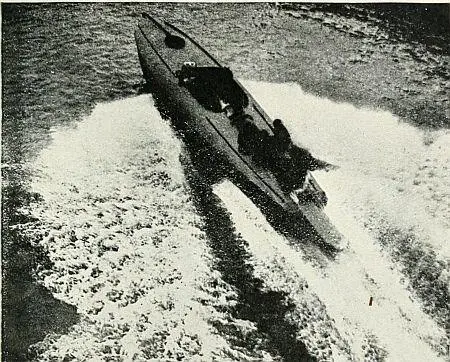
Thornycroft & Co., Ltd.
A 40-ft. Coastal Motor Boat Travelling at Full Speed
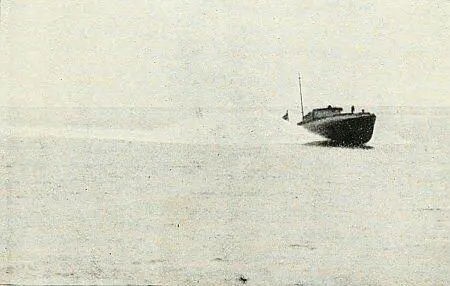
Thornycroft & Co., Ltd.
A 40-ft. Coastal Motor Boat Travelling at Full Speed
It is not difficult to imagine a fight between a C.M.B. travelling at 40 knots, firing with its little Lewis gun at a big seaplane swooping down from the clouds at the rate of 70 miles an hour, and splashing the water around the frail little grey-hulled scooter with bullets from its machine gun. This actually occurred many times off the Belgian coast, and is a typical picture of guerrilla war at sea in the twentieth century.
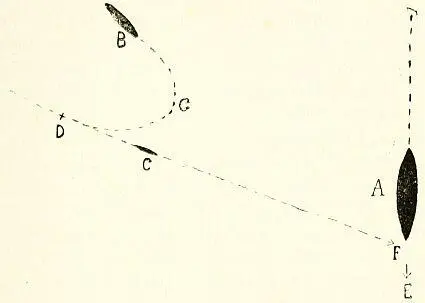
Fig. 5.—Diagram illustrating method of attack by C.M.B. on surface ship (or submarine on surface). A. Object of attack travelling in direction indicated by arrow E. B. The position of the C.M.B. after delivering the attack. C. The torpedo, released by the C.M.B. at point D , travelling on course ending at F , which, allowing for movement of ship A , is the place where the torpedo should strike its object of attack. From this it will be seen that the torpedo, when released, actually follows the ship from which it is fired until the latter swerves from the straight course, when the torpedo continues until it strikes or misses the object of attack, the speed of the torpedo being about the same or a little less than that of the C.M.B. The total time occupied in such an attack over a course of two miles would be about 2½ minutes before the torpedo struck its object.
The C.M.B. was a purely British design, and the firm largely responsible for the success achieved was Messrs John J. Thornycroft & Company Limited. There were bases for these sea-gnats at Portsmouth, Dover, Dunkirk, and in the Thames Estuary at Osea Island. From all of these points mid-Channel could be reached in less than thirty minutes. Although useless in rough weather, a trip in a C.M.B., even on a calm day, was sufficiently exciting. The roar of the engines made speech impossible, and vision when sitting in the little glass-screened well, or conning-tower, was limited by the great waves of greenish-white water which curved upwards from either bow, and rolled astern in a welter of foam. There was an awe-inspiring fury in the thunder of the 700 h.p. engines revolving at 1350 per minute, and a feeling of ecstasy in the stiff breeze of passage and the atomised spray. When waves came the slap-slap-slap of the water as the sharp bows cleft through the crest and the little vessel was for a brief moment poised dizzily on the bosom of the swell caused tremors to pass through the thin grey hull, and, to complete the review of sensation, there may be added the human thrill of battle and the indescribable feeling of controlled power beneath one’s feet.
The C.M.B.’s record of service, although short, is nevertheless a brilliant one. Towards the close of the year 1916 four of these little vessels coming from the base at Dunkirk intercepted five German destroyers returning from a Channel raid. The scooters raced towards the enemy in a smother of foam. Every quick-firing gun on the German ships spouted shells at the mysterious white streaks approaching them with the speed of lightning. So close did these plucky little ships go to their giant adversaries that the blast of the German guns was felt aboard, but no shells struck them. Then the line of C.M.B.’s swerved and their torpedoes were launched at close range. One of the enemy destroyers was hit and badly damaged, while two others had narrow shaves.
There was no time for German retaliation. For a brief few minutes the sea around the scooters was ploughed up by the shells from the Hun artillery, then the four little attacking craft were five miles distant from the scene of their victory, and presented almost invisible white specks to the enemy gunners.
At Zeebrugge these craft ran close in under the guns of the shore fortifications, and covered the approach of the landing parties and block-ships with a screen of artificial smoke. At Ostend they entered the harbour under heavy fire and ignited flares to enable the block-ships to navigate in the darkness. Others, in the same operations, torpedoed the piers and silenced the guns mounted thereon.
Their exploits savour of old-time sea romance, as, for example, when the little Condor ran in under the guns of the fortress of Alexandria, or further back in our naval history, when sail and round shot took the place of petrol and torpedoes.
For anti-submarine work these wonderfully fast little chasers were used in small flotillas. They were fitted with short-range wireless sets, and when the message came stating that a vessel was being attacked in a certain position, perhaps twenty miles from the coast, a number were instantly released from the leash, and in a fraction of the time taken by larger vessels they were on the scene with torpedoes and Lewis guns for surface attack and depth charges for submerged bombing.
They were commanded, in many instances, by R.N.V.R. officers of the auxiliary service, and carried two engineers. No crew was necessary, nor was space available for them. The plucky dash of these vessels into the harbours of Zeebrugge and Ostend, their subsequent operations on the Belgian coast, and their losses in the action at the entrance to the Heligoland Bight in 1918, when they were launched from a big ship, have earned for them high renown in naval history.
Читать дальше
